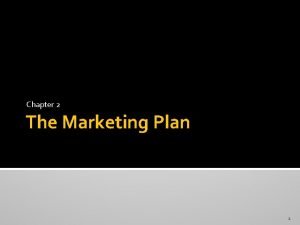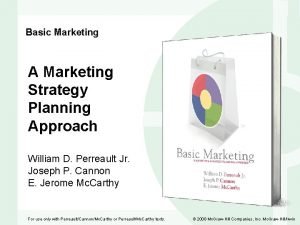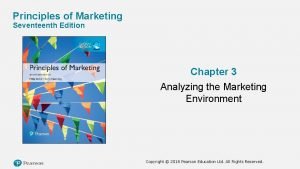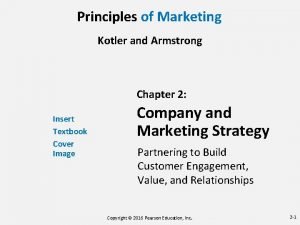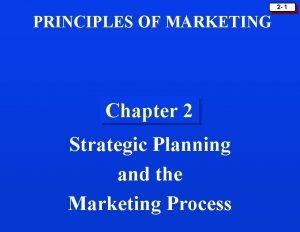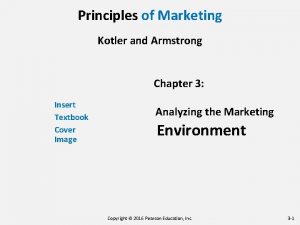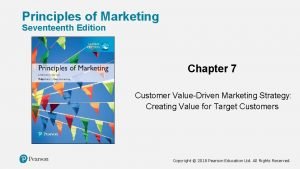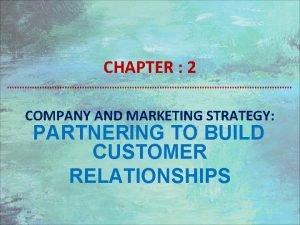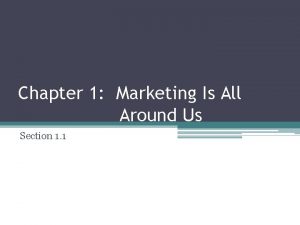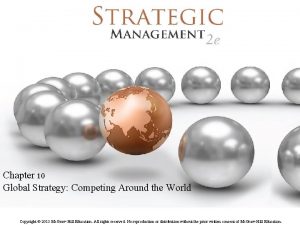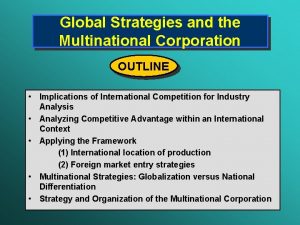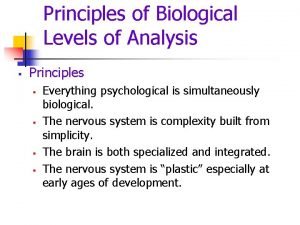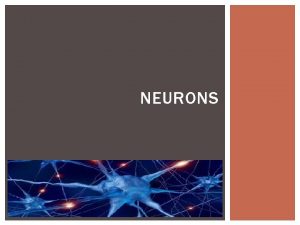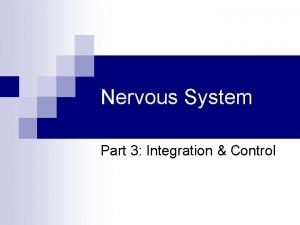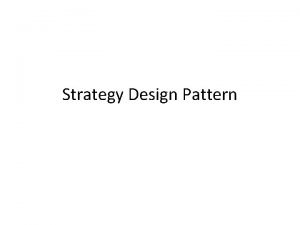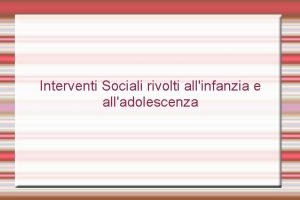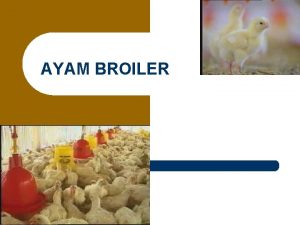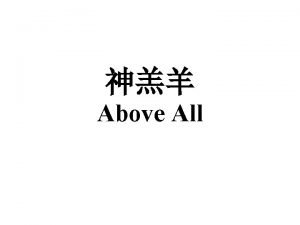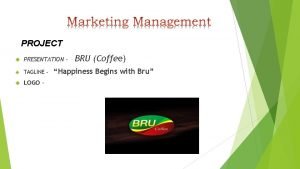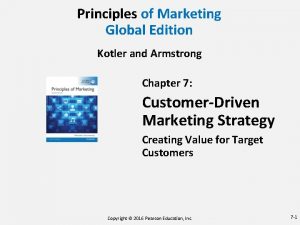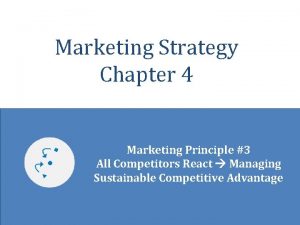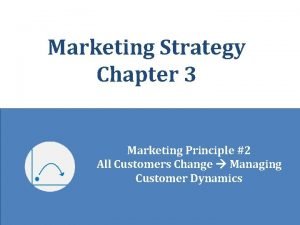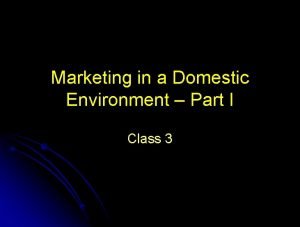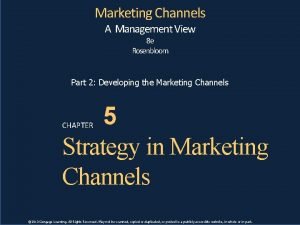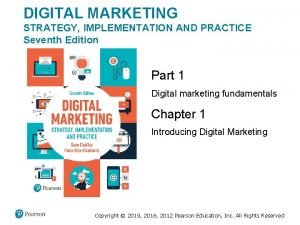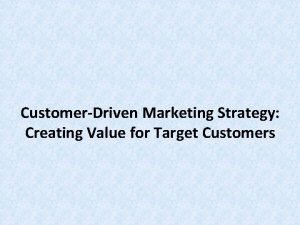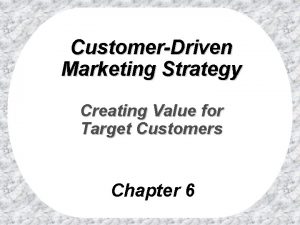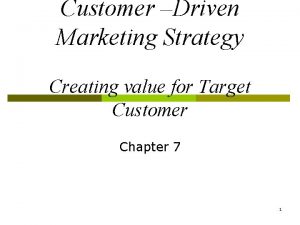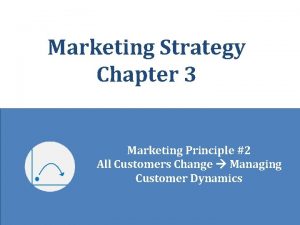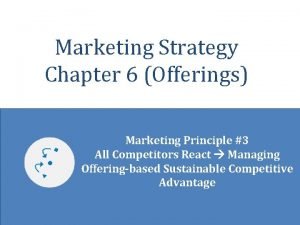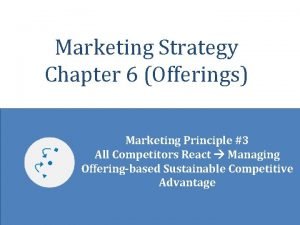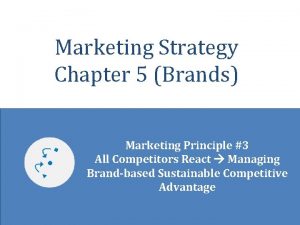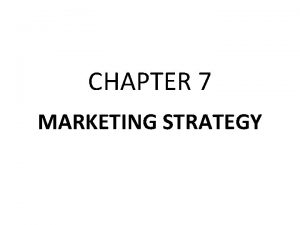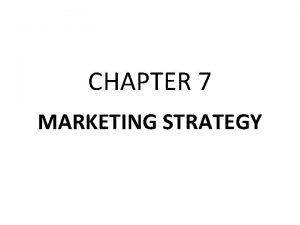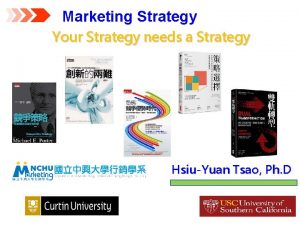Marketing Strategy Chapter 3 Marketing Principle 2 All

























































- Slides: 57

Marketing Strategy Chapter 3 Marketing Principle #2 All Customers Change Managing Customer Dynamics © Robert Palmatier 1

Agenda n Introduction n Approaches for Managing Customer Dynamics n Evolution of Approaches for Managing Customer Dynamics Lifecycle Approach Customer Dynamic Segmentation Approach Customer Lifetime Value Approach Choice Models Framework for Managing Customer Dynamics Inputs to Managing Customer Dynamics Framework Outputs of Managing Customer Dynamics Framework Process for Managing Customer Dynamics n Managing Customer Dynamics Example n Takeaways n Case © Palmatier 2

All Customers Change n Another underlying issue facing managers that make marketing decisions difficult is that all customers change n Customer’s desires/needs for most products and services change over time or due to specific events n Individual consumer needs change (age, experience, and due to trigger events) Customers are embedded in industries/markets, which change overtime (PCs 20 years ago and now) Customer's needs vary not only due to inherent differences in people (heterogeneity) but also as people and markets change (dynamics) n Thus, we need to adapt our “static” segmentation of all customers based on “generic” needs (MP#1) by focusing on our existing customers and accounting for their time dependent needs (MP#2) n Customer dynamics are changes in customer preferences that occur over time © Palmatier 3

Exercise on Customer Dynamics n Everyone take a few minutes to describe your or your parents past car purchases n Car at 20 ________ Top two reasons bought _____ & ______ n Car at 30 ________ Top two reasons bought _____ & ______ Trigger for change ________ n Car now ________ Top two reasons bought _____ & ______ Trigger for change ________ © Palmatier 4

5 Sources of Customer Dynamics n Discrete life events n Typical lifecycle n Learning effects n Product lifecycle n Constantly changing environmental context © Palmatier 5

Sources of Customer Dynamics Description Rate of Change Examples Discrete life events Immediate A first-time parent often changes their preference for cars, vacations, and restaurants. Typical lifecycle or maturation as people age Slow As people age, they become more focused on risk reduction, less willing to change, and more focused on comfort and health. Product learning effects Medium Customers might learn, after using a product for a time, that there are certain specialized or high-tech features they would like. Medium During early stages, consumers may purchase more new features, in later periods, they may get more price sensitive. Slow to immediate As the culture around “health food” changes, consumer preferences in response to dietary concerns (e. g. , calories, sodium, carbohydrates, gluten, fat) also change. Individual level Product market level Product lifecycle Environmental level Changes in economy, government, industry, or culture © Palmatier 6

Customer Dynamics: A Fundamental Assumption of Marketing Strategy n Thus, customer dynamics is a fundamental “problem” that all firms must address when developing an effective marketing strategy n Customers change; failure to understand address these dynamics will lead to poor business performance Marketing principle #2: all customers change and an effective marketing strategy must manage customer dynamics © Palmatier 7

Example: General Motors n n Buick: failure to manage customer dynamics Customers needs changed, customers moved to different suppliers Left Buick with a smaller portfolio of older customers Brand became associated with the elderly; sales dropped 50% Acura: success in managing customer dynamics Honda realized its customers were migrating to more expensive cars Launched Acura: a higher priced luxury car targeted to those customers Within a few years, Acura was one of the best-selling luxury brands in the US © Palmatier 8

Agenda n Introduction n Approaches for Managing Customer Dynamics n Evolution of Approaches for Managing Customer Dynamics Lifecycle Approach Customer Dynamic Segmentation Approach Customer Lifetime Value Approach Choice Models Framework for Managing Customer Dynamics Inputs to Managing Customer Dynamics Framework Outputs of Managing Customer Dynamics Framework Process for Managing Customer Dynamics n Managing Customer Dynamics Example n Takeaways n Case © Palmatier 9

Evolution of Approaches for Managing Customer Dynamics n Lifecycle Approach uses generic stages of growth and their position in the lifecycle to determine customer preferences and associated strategies n Dynamic Customer Segmentation segments a firm’s existing customers on the basis of their similar, expected migration patterns n Customer Lifetime Value captures the contribution of each customer according to his or her expected migration path over the entire lifetime with the firm © Palmatier 10

Evolution of Approaches for Managing Customer Dynamics Fast Speed of Response Slow All Customers Size of Segment Managed Lifecycle Approach Uses generic customer stages of growth and their position in the lifecycle to determine customer preferences and associated strategies. • Customer lifecycle • Product lifecycle • Industry lifecycle Niche Segment Dynamic Customer Segmentation Customer Lifetime Value Segments a firm’s existing customers on the basis of their similar, expected migration patterns. Captures the contribution of each customer according to his or her expected migration path over the entire lifetime with the firm. • Uses discounted cash flows • Accounts for expansion and retention expectations • May use hidden Markov models • May use lost customer analysis Pros Cons Simplicity Assumes all customers follow one curve Combines lifecycle and segmentation methods Segments are not perfectly homogeneous Provides insights for AER decisions Requires insight into future migration Averages all customers Matches strategic marketing thinking Puts continuous change into discrete stages Supports a customercentric culture Requires detailed financial data Ease of use Ignores causes of customer dynamics © Palmatier Identifies temporally homogeneous groups Captures dynamics and heterogeneity 11

Lifecycle Perspective: “Ok” First Approximation n Assumes “all” customers, markets, products, industries move thru a sequential set of “stages” as they mature n Applies a standard set of marketing tactics at each stage n Pros: Easy to apply Makes common sense n Cons: Misses many unique trigger points and migration paths (ignores temporal heterogeneity) Inaccurate and/or ineffective for many firms © Palmatier 12

Different Lifecycle Approaches n Customer lifecycle attempts to capture how individuals typically change as they age and reach common age-related milestones n Product lifecycle proposes that various products go through four typical stages in relation to their acceptance by society: introduction, growth, maturity, and decline n Industry lifecycle comprises of five stages: 1. Early establishment of its range and boundaries 2. An innovation stage to set a “dominant design” 3. 4. 5. © Palmatier The shakeout stage, marked by economies of scale, such as that smaller players get forced out Maturity, when firms focus on market share and cash flows The decline stage, when sales decay for the industry as a whole 13

Typical Customer Product Lifecycle Growth Maturity • Product just launched on the market, often perceived as risky by customers. • Product gains acceptance in the market, and sales expand quickly. • Most relevant features are still unknown by customers and sellers. • Users are more comfortable with the product and know which features they want. • Product is widely accepted, and growth begins to slow, because fewer new users are available. • High prices. • More focus on retaining customers and generating repeat sales. Decline Sales Introduction Descriptions of the Stages • Seller focuses on finding new customers and promoting product trials. © Palmatier • Customers become increasingly price sensitive. • Destructive competition and changing consumer needs and desires lead to product decline. • Market becomes • Firms’ sales and profits competitive, and some firms decline. drop out. • Firms with higher cost and • Intense price competition those without a unique reduces profits. advantage exit the market. • Some sellers focus on niche segments to avoid competitive pressures. • Market often consolidates with fewer suppliers. 14

Customer Dynamic Segmentation Approach n Evaluates existing customer’s behaviors/needs in each AER stage to understand temporal differences Customers are “temporally” similar in each stage (assumption) Matches marketing action domains (i. e. , acquisition is often a self-contained marketing domain) n Dynamic-based segmentation is sometimes called the Acquisition–Expansion– Retention (AER) model, because it captures customers entering the firm’s portfolio and expanding over time, even as other customers slowly leave Acquisition stage begins with first contact, typically before the first purchase occurs, when prospects and early customers have similar needs Expansion stage has firms that are trying to upsell or cross-sell to expand their sales and engagement with existing customers Retention stage deals with customers who migrate not because of a mismatch in the core offering or a life event but because they have a basic propensity to switch, in pursuit of “greener pastures” © Palmatier 15

Customer Dynamic Segmentation Approach (AER Model) © Palmatier 16

Example: AER Strategies Emerge from a Dynamic Segmentation in B 2 B Market n Uses Hidden Markov Models (HMM) n Simultaneously clusters and links clusters Give probabilities of moving among segments # clusters are data driven versus AER Can evaluate what strategies trigger or drive migration n Example of 346 B 2 B customers over 6 years n Migrations even occur in a mostly stable B 2 B customer portfolio © Palmatier (See Data Analytic Technique 3. 1 for more details of HMM) 17

DAT 3. 1 Hidden Markov Model (HMM) Analysis When to Use It Description • To understand the dynamics (or stages) stages of a customer’s relationship with a business. • To dynamically segmentation the customer base. • To predict when a customer might change stages, which may imply more or less value for the firm. • To determine when to proactively seek to build customer relationships. Hidden Markov models (HMM) can uncover stages or “states” of customer behaviors, as well as how those states evolve. Because each state describes the common behaviors exhibited by some group of customers at some point in their relationship with a firm, HMM is a form of dynamic segmentation. How It Works • A customer’s relationship with a firm exists in one of several possible unobserved (or hidden) stage, each with finite probability. Customer behavior varies depending on the stage, such that a “stronger” stage customer likely buys more than one in a “weak” stage. In HMM, customers also have a finite probability of transitioning from any one stage to another, partially as a function of marketing efforts. For example, advertising might cause customers to shift from a weaker to a stronger stage. • Customer behaviors (e. g. , purchases) and firm actions (e. g. , marketing) serve as inputs to the HMM, which estimates five outputs: (1) the number of feasible states (or dynamic stages) in the data; (2) initial probability that a customer is in each state; (3) transition probabilities, or the probability that customers move from one state to another; (4) the conditional probability of a behavior, given the customers’ hidden state; and (5) the effect of marketing in moving customers across stages. Example To dynamically segment alumni donation behavior and investigate which of its marketing activities prompt donors to give money, ABC University conducted a HMM analysis that identified three hidden states: dormant (corresponds with no donation), occasional (corresponds with infrequent donation), and active (corresponds with frequent donation). With low marketing effort, dormant customers remain dormant in the next period with a 90% probability (red text); active customers have a 33% chance of becoming occasional in the next period (green text). With high marketing effort though, the dormant customers become occasional donors with a 57% probability (red text), and active customers exhibit only a 25% chance of becoming occasional (green text), both of which are good for ABC. Dormant Occasional Active Dormant 0. 40 0. 57 0. 03 0. 37 Occasional 0. 03 0. 50 0. 47 0. 65 Active 0. 00 0. 25 0. 75 Dormant Occasional Active Dormant 0. 90 0. 10 0. 00 Occasional 0. 08 0. 55 Active 0. 02 0. 33 Transitions: Low Marketing Effort © Palmatier Transitions: High Marketing Effort

Hidden Markov Model Example: Relationship States and Migration Paths Strong Relationships Communal State (61%) Endowment Migration 62% 16% 21% Transitional State (29%) Exploration Migration 35% 7% Neglect Migration Weak Relationships Transactional State (50%) Recovery Migration 38% Damaged State (57%) © Palmatier 13% Betrayal Migration Poor Relationships 19

Insights for B 2 B Hidden Markov Model Example n States in HMM describe different types of behavior that the same (or different) consumers might exhibit at different points of time; transitions among states capture the notion that consumers can switch from one state to another at any point in time In the transactional state, the relationships indicate low levels of customer trust, commitment, dependence, and relational norms If customers follow a positive migration path and move to the transitional state, they do so only briefly In the communal state, the levels of trust, commitment, dependence, and relational norms are higher than in any other state, and the relationship produces good cooperation and profit The damaged state produces low levels of trust and commitment and very low relational norms and cooperation, though customer dependence tends to stay high © Palmatier (See Data Analytic Technique 3. 1 for more details) 20

Customer Lifetime Value (CLV) is a Key Analysis Tool for Making AER Decisions n How do you know best customers to acquire/expand/retain? In many banking initiatives only 1 in 3 “customers” remain after incentive ends Are all customers worth acquiring or retaining? n CLV approach: evaluates a firm’s profit as the sum of each customer’s lifetime discounted cash flows n Approach captures “true” contribution of each customer at any stage by accounting for: Customer heterogeneity and dynamic effects (individual level, uses transition expectations, and discounts future profits) Tradeoffs among AER strategies (e. g. , how acquisition may affect retention) © Palmatier 21

CLV Approach (Australia and New Zealand CMO Survey) n Survey conducted on 255 CMOs and marketing directors in Australia and New Zealand n Those who “always measure the lifetime value of each customer” achieved a 16% average increase in their annual marketing budget as compared to 0% for those who do not measure it. n 75% of the marketers are engaged in some level of CLV effort within the organization © Palmatier 22

CLV Accounts for Varying Profits Across Customers n Beyond 80/20 rule: firms earn 150% of their profits from 30% of their customers n CLV captures these difference in your existing customers so you can acquire, expand, and retain the “best customers” © Palmatier The Right Customers: Acquisition, Retention, and Development (HBR Press) 23

CLV Accounts for the Time Varying Profits of Your Customers n On average, annual earnings typically increase over a customer's life due to cross/up-selling n But, some customers are more costly to acquire or retain (lowering prices, high service levels) © Palmatier The Right Customers: Acquisition, Retention, and Development (HBR Press) 24

Customer Lifetime Value (CLV) Analysis n Need cash flow (sales - costs) for individual customers or group of customers n Calculate CLV of each customer: n Where CFi, t = net cash flow generated by the customer i at time t T = time horizon for estimating the CLV d = discount rate n CLV is the “value” added, by an individual customer, to the company n CLV approach is a form of customer-centric accounting where firm’s value is the sum of all its customers’ CLV © Palmatier 25

Simplified Customer Lifetime Value Analysis n Several simplifications make CLV calculations even more straightforward n Assuming that T infinity and that the contribution margin and marketing costs (weak) do not vary over time n Assuming that the contribution margin and marketing costs do not vary over time, the CLV in dollars for the ith customer reduces to just five inputs: 1. Mi = margin for ith customer in $ (sales $ and margin as %) 2. Ci = annual marketing cost for ith customer in $ 3. ri = retention rate for ith customer as a % 4. d = discount rate as a % 5. Ai = acquisition cost for ith customer in $ © Palmatier 26

DAT 3. 3 Customer Lifetime Value (CLV) Analysis When to Use It Description This method quantifies the future discounted profitability of a customer. It breaks down firm- or product-level profitability to the customer level, enabling a customercentric approach. • To identify which customers are worth acquiring and retaining. • To determine where to target marketing programs to maximize the firm’s return on marketing investments. • To understand the “true” value of a customer to a firm, including both revenues and costs. How it Works Customer lifetime value is the dollar value of a customer relationship, according to both its present value and the projected future cash flows from the relationship. The calculation process consists of three steps: (1) estimating the remaining customer lifetime, or number of years over which a customer is likely to maintain a relationship with the firm, normally according to retention rates; (2) forecasting net profits from the customer over the predicted lifetime, and (3) calculating the net present value of the future amounts. Because CLV ranks customers on the basis of profitability, it can target marketing campaigns toward the most high value customers. The CLV formula is given as follows. # of Customers Both current and potential customers can be segmented according to expected long-term profits or CLV. The graph below plots the CLV distribution of firm, which consists of inactive customers (low to negative CLV), active customers (positive CLV), and highly active customers (very high CLV) shows that the right portion of the graph below highlight a firm’s most active customers). Firms can use such a graph to identify and target the most profitable customers for marketing retention campaigns. Inactive Customers Active Customers Highly Active Customers CLV Example A manager of a cable company wants to determine if it is strategic to acquire the Brett family, by estimating their household-level CLV. The manager estimates that it will cost the company $65 (A) to get the Bretts’ to switch, and the Bretts’ will generate $100 profit each year (M), with a $10 annual marketing cost to retain them (C). The estimated retention rate (r) is 65%, and the current discount rate is 5%. (d). From the formula, the CLV for the Brett’s is $235, which suggests the Brett’s on net, are profitable to the cable company. © Palmatier

Example: RBC (Canada) n Royal Bank of Canada (RBC) n Identified medical students as high CLV customers n Implemented a program to satisfy their needs early during the progression of their careers: products such as credit cards, help with student loans, and loans to set up new practices. n In the first year, RBC’s market share in this segment increased from 2% to 18% and average sales were four times higher than average customers. . These customers were also very loyal. © Palmatier 28

Some Generalizations on AER Strategies from CLV Analysis n AER strategy that maximizes CLV maximizes neither the acquisition rate nor retention rate n Investments in customer acquisition and retention have diminishing marginal returns n Under spending in acquisition and retention is more detrimental and results in smaller CLV than overspending n A suboptimal allocation of retention expenditures will have a larger detrimental impact on long-term customer profitability than suboptimal acquisition expenditures © Palmatier (Kumar 2005) 29

Customer Referral Value (CRV) n What is the lifetime value of a customer bringing you another customer? n Highest CLV customers do not always generate the highest CRV (weakness of CLV) n “Advocates” real value is higher than a CLV would predict so you need to protect these customers (3 x more in one study) n Identify advocates: protect, enable, expand Referral programs How to build advocates (Apple, BMW, not Wal-Mart) © Palmatier (Kumar, Peterson, and Leone 2007) 30

RFM Analysis is “Poor Man’s” CLV n Direct marketers have been using a simplified version of the CLV for decades, targeting customers to receive expensive catalog mailings. They use three readily available customer behaviors: Recency or time elapsed since last purchase Frequency of purchases in last period Monetary purchases in last period n These RFM (recency, frequency, and monetary) variables put customers in rank-ordered groups, based on their value in the past year (not by modeling but by rank-order sorting) n Using the profits generated from a test mailing to a few customers from each group, direct marketers then mail the catalog only to the groups with an acceptable return on investment © Palmatier 31

RFM Code Construction Where Higher Numbers are Better R 5 F 35 4 3 2 34 33 32 31 1 Database © Palmatier Five Sorts M 335 334 333 332 331 Twenty-five sorts One Sort 32

Breakeven Analysis Test of a Expansion Strategy Using RFM Analysis for Mailing Catalog mailing is above breakeven for customers with these RFM codes RFM Cell © Palmatier 33

Lost Customer Analysis Informs AER Strategies n A firm contacts customers that have migrated away, to identify the cause for this change, then works backward to fix the problem and ensure other customers don’t leave for the same reason n Takes a significant number of lost customers before a firm recognizes that it isn’t just “normal” customer churn but rather an indication of an underlying problem n Three-step process, which provides insights into both strengths and weaknesses: 1. 2. 3. n Firms set regular intervals for contacting lost customers to identify the cause of their transition, where they went, and potential recovery strategies If the lost customer is not in the firm’s main target segment, firms could: a. Change their acquisition criteria b. Evaluate an expansion strategy to address a new subsegment of customers If the lost customer is in the firm’s target market, firms should: a. Fix the problem b. Implement retention strategies to build brand relational loyalty A choice model can benefit the lost customer analysis, and can inform analyses across all AER stages, because it predicts the likelihood of observed customer choices/responses, using data about that customer’s characteristics and past behaviors, as well as the firm’s marketing interventions © Palmatier 34

What are Choice Models? n n Analysis approach that attempts to determine the impact of different factors (price, promotion) on consumer’s individual choices (joining, cross buying, leaving) Most popular individual-level response model Uses past behavioral data No need to survey or get customer input (infers weights from past customer's behaviors) Determines probability of choices and elasticities of marketing variables While regression analysis… Is not an individual model and uses continuous outcomes Gives weights of inputs, but not probabilities or elasticities Does not use “logit model, ” which is better predictor of how people act by capturing diminishing effects (inputs have less effect as you do it more) © Palmatier (See Data Analytic Technique 3. 3 for more details) 35

Choice (Logit) Models Integrate Important Characteristics of Consumer Behavior High Marginal Impact of a Marketing Action Low 0. 0 0. 5 1. 0 Probability of Choosing an Alternative n Assumes that consumers make rational choices based on their individual utility with a diminishing sensitivity for marketing effort n Thus, marketing has the highest effect on people who are “sitting on the fence” (i. e. , probability of. 5 of choosing an alternative) © Palmatier (See Data Analytic Technique 3. 2 for more details) 36

Choice Models are Excellent for Determining “Best” AER Strategies n After determining AER positioning for each stage and ranking personas on CLV, then you need to develop effective AER marketing strategies n Use database of past marketing actions and demographics linked to actual customer responses (choices) in a stage as input to choice model n Choice model will provide: Elasticity for every input variable on outcome (e. g. , how does age, kids, credit, and direct mail impact choice) Elasticity = % change in output / % change in input Probabilities of customer’s choice (probability of upselling, retaining, and can run on lists for acquisition targeting) n Latent class choice models: “clusters” and runs choice model at the same time (segments on elasticity to IVs, same things work for segment) © Palmatier 37

Example of Choice Model on MBA Choice Observations / Choice data 1 2 3 4 5 6 7 Choice (0/1) 1 0 0 1 1 0 0 Intensity of contact with Distance to Coworkers in Income level EMBA (internet, campus the program mailing, call, visit) 3 6 6 7 2 5 3 7 4 4 7 7 6 1 1 7 7 1 1 6 6 7 3 7 7 7 3 3 n Inputs (no survey needed, infers importance of criteria from behavior) Family income level Intensity of contact with EMBA office (internet, mail, call, visit) Distance to campus from home Coworkers in the program © Palmatier 38

Customer Choice Determines Coefficient Estimates, Probabilities, and Elasticities Coefficient Estimates Elasticities Variables / Coefficient Standard t-statistic estimates deviation Income level Intensity of contact with EMBA (internet, mailing, call, visit) Distance to campus Coworkers in the program Const-1 Baseline 1. 700397 1. 172524 1. 450202 23. 18698 50. 94818 0. 455109 -1. 0191 0. 508133 -2. 00548 2. 092535 1. 125706 1. 858866 -151. 835 Elasticities of Income level Response Dummy 307. 1951 -0. 49426 n/a Response Dummy Respondents / Choice Response Dummy Predicted Observed probabilities probability Response Dummy © Palmatier 1. 000 0. 017 0. 159 0. 476 0. 000 0. 983 0. 841 0. 524 1 0 0 1 1 0 Dummy 0. 245253 -0. 38359 0 0 Elasticities of Intensity of contact with EMBA Response (internet, mailing, call, visit) Probabilities 1 6 12 32 Response 5. 474283 0 Dummy -8. 5622 0 Elasticities of Distance Response Dummy to campus Response -0. 25866 0. 404571 Dummy 0 0 Elasticities of Coworkers in the program Response Dummy 0. 549165 -0. 85894 0 0 39

DAT 3. 2 Choice Model Analysis Description A choice model is a mathematical model that predicts how the likelihood of an observed customer choice or response, is influenced by a firm’s marketing interventions, and/or customer characteristics. When to Use It • • To determine a customer’s most likely choice when faced with many product alternatives. To determine the most important factors that influence customer choice likelihood. To segment and target customers according to the similarities in their choice drivers. To simulate the potential market share for various products on the basis of customer choice. How it Works • In a choice model setting, every individual is assumed to derive an unobserved product-specific utility from several product options. The individual is assumed to pick the product option that provides the maximum utility. The dependent variable in a choice model is binary: every individual chooses (or does not choose) a product option. • Every product option’s attractiveness is assumed to stem from a finite set of attributes (e. g. , brand name, price, advertising). The independent variables in a choice model are the measure of the strength of attributes of each of the product option, e. g. , product option 1 may have a low price, while product option 2 may have a higher price. • The model uses the two inputs (dependent variable, independent variables) to estimate several outputs. First, it provides the weights (or coefficients) that each attribute would have had to cause customers to pick a certain product. This provides the most important factors that influence customer choice likelihood. • Second, it is used in a predictive sense. For example, when we only observe product attributes, we can use the attributes and the weighs of the model to predict the choices that are likely to be made by a new set of customers. This in turn can help a firm segment and target customers based on choice likelihood. • Third, the model can be used to simulate the market share of a product category, by adding up the product choices made by all customers faced with all products. This can help manages plan their marketing efforts. Example A retailer is planning to introduce a store brand of bleach (Store Brand “C”) in their bleach category, which predominantly has two national brands (Brand “A” and Brand “B”). The manager responsible for the store brand obtains transaction data from all the retail stores on the sales, price and promotional efforts by Brand A and Brand B. With a choice model, the manager learns the weights and elasticities associated with price and promotional efforts respectively. A 1% increase in the price of Brand A decreases the sales of Brand A by 2. 7%, while it increases the sales of Brand B by 1. 6%. A 1% increase in the price of Brand B decreases the sales of Brand B by 3. 7%, while it increases the sales of Brand A by 1. 2%. A 1% increase in promotional intensity (a 10% price cut for 2 weeks) by Brands A and B increases their respective sales by 8% and 6% respectively. The model fits the data very well, and hence the retail manager feel confident about the results. Also, the manager learns that frequent price promotions, and lower price do help increase market share significantly. Hence, the retail manager decides to introduce the store brand (Brand C) as a low price, generic version of bleach (price 20% below Brands A and B), with promotions held 20% more frequently than Brands A and B. The goal of the store brand introduction is to steal market share from Brands A and B, especially in a category where price seems to have a large effect on sales (as learnt from a choice model). © Palmatier

Agenda n Introduction n Approaches for Managing Customer Dynamics n Evolution of Approaches for Managing Customer Dynamics Lifecycle Approach Customer Dynamic Segmentation Approach Customer Lifetime Value Approach Choice Models Framework for Managing Customer Dynamics Inputs to Managing Customer Dynamics Framework Outputs of Managing Customer Dynamics Framework Process for Managing Customer Dynamics n Managing Customer Dynamics Example n Takeaways n Case © Palmatier 41

Marketing Principle #2: All Customers Change Managing Customer Dynamics Inputs (CRM data) Your Customers • Individual customers’ sales, margins, costs • Behaviors/needs over time/events Past Marketing Programs • Source of customers • Past programs targeted at specific customers Lost Customers • Cause of defection • Characteristics of lost customers © Palmatier Managing Customer Dynamics Outputs (AER) Segmentation of Customers Approaches & Processes Lifecycle approach Dynamic segmentation approach Acquisition, expansion, retention (AER) model Lost customer approach Analyses Customer lifetime value (CLV) Hidden Markov model (HMM) Choice models Factor, cluster, discriminant analyses • Customer personas • Needs and CLV of personas • Why and how they migrate AER Positioning Statements • How best to position the firm in each persona/AER stage AER Strategies • What marketing strategies work best for each persona/AER stage 42

Inputs to the Customer Dynamics Framework 1. The firm’s existing customer portfolio – ideally a firm’s CRM system provides detailed customer-level data for the dynamic segmentation analysis 2. Data linking past customer responses with specific marketing programs and the programs’ cost 3. The qualitative and quantitative information gleaned from the lost customer analysis, which reveals the causes of customer defection, where they go, and potentially effective recovery strategies © Palmatier 43

Outputs of the Customer Dynamics Framework A description of the firm’s customer personas and expected migrations to understand how they change, including: 1. n n n Critical life event triggers The products and services they buy at different points in their lifecycle migration When they stop buying and why How they feel at different stages in their lifecycle The CLV of customers in each persona 2. AER Positioning statements – how to best position the firm in each persona/AER stage 3. AER strategies – what marketing strategies work best for each persona/AER stage © Palmatier 44

Process for Managing Customer Dynamics To convert CRM, marketing program, and lost customer input data into dynamic segmentation and AER positioning statements and strategies, managers should follow a series of steps: 4. Dynamic segmentation Migration Paths and Triggers Customer Lifetime Value of Segments and Migrations AER positioning statements 5. AER strategies 1. 2. 3. © Palmatier 45

Agenda n Introduction n Approaches for Managing Customer Dynamics n Evolution of Approaches for Managing Customer Dynamics Lifecycle Approach Customer Dynamic Segmentation Approach Customer Lifetime Value Approach Choice Models Framework for Managing Customer Dynamics Inputs to Managing Customer Dynamics Framework Outputs of Managing Customer Dynamics Framework Process for Managing Customer Dynamics n Managing Customer Dynamics Example n Takeaways n Case © Palmatier 46

Dynamic Segmentation: Hotel Example Steps to Dynamic Segmentation 1. Segment customers in each AER stage and name the related personas 2. Find the migration paths, triggers, and CLVs of each persona 3. Determine the AER positioning statement and strategies (who, what, why, and how) for each persona to maximize sales and profits, based on the CLV of these personas © Palmatier Migration Path Triggers Path A: The main trigger point appears to be positive interactions with the manager or key staff (20 percent of time). Path B: The main trigger is being offered upgraded services on first visit (20 percent of the time). Path C: The main trigger is poor customer experience due to Internet speed or insufficient work space (30 percent of the time). Path D: The main trigger is either low perceived value or poor interactions with hotel staff (30 percent of the time). 47

Markstrat Simulation: Making Decisions When Dealing with Customer Dynamics Managing Developed Markets (Sonites) as Customer Segments Change Segment Descriptions Growing customer segments High Earners • • • High income level Demand performance and convenience Purchase expensive products Professionals • • • Personal and professional usage Look for high quality, high-performance products Can afford expensive products Savers • • • Cautious in the way they spend their money Demand cheap, average convenience products Future growth rate could exceed forecasts Shoppers • • • Good product knowledge through comparison Demand high quality–price ratio Quite price-sensitive Pricing pressures Shoppers Savers High Earners Professionals Changing customer needs Competitive product launches Managing Developing Markets (Vodites) as Prototypical Customer Segments Emerge Sales Followers segment Early adopters segment Innovators segment © Palmatier Time 48

Agenda n Introduction n Approaches for Managing Customer Dynamics n Evolution of Approaches for Managing Customer Dynamics Lifecycle Approach Customer Dynamic Segmentation Approach Customer Lifetime Value Approach Framework for Managing Customer Dynamics Inputs to Managing Customer Dynamics Framework Outputs of Managing Customer Dynamics Framework Process for Managing Customer Dynamics Choice Models n Managing Customer Dynamics Example n Takeaways n Case © Palmatier 49

Takeaways n The second underlying challenge that firms face when making marketing decisions is that all customers change. This principle can be either an opportunity or a threat, depending on how well the firm understands and manages it. n Customer dynamics arise from five sources: Individual customers change due to life events and move through typical lifecycles as they age. Customer learning effects occur as customers gain knowledge about a product category. Learning and experience effects also operate at a societal level. Finally, each customer is situated in an environmental context that is constantly changing, filled with outside entities trying to change the customer’s perceptions and behaviors. Each source works simultaneously and cumulatively to create customer dynamics. © Palmatier 50

Takeaways n Due to rapid technological and communication developments, the speed at which customers change and their expectations about firms’ response times have increased. n There are three approaches to managing customer dynamics: lifecycle, customer dynamic segmentation, and customer lifetime value approaches. n The lifecycle approach predicts that customers, products, and industries go through similar lifecycles that can be used to inform marketing decisions at different stages. This approach can be problematic though, because it assumes an average rate of change. © Palmatier 51

Takeaways n The customer dynamic segmentation approach, with an AER model, predicts that acquisition occurs when customers are just beginning to interact with the firm (customer onboarding). Expansion is when the firm tries to cross-sell or upsell customers and increase engagement, and retention involves keeping customers who might otherwise tend to migrate to competitors. Hidden Markov models (HMM) can uncover states, reflecting how a large set of customer behaviors changes over time. A state is similar to a consumer segment, describing common behaviors by a group of consumers at some point in their relationship with the firm. Thus, HMM enables dynamic segmentation. As a powerful diagnostic tool, lost customer analysis can be integrated into a customer dynamic segmentation approach. It often features a mathematical choice model that predicts the likelihood of an observed customer choice or response (e. g. , joining, cross-buying, leaving), according to data gathered from the firm’s marketing interventions and customer characteristics. © Palmatier 52

Takeaways n Customer lifetime value (CLV) seeks to capture the true contribution of each customer, according to the migration path this customer is predicted to follow throughout the relationship with the firm. This approach beneficially provides guidance for making trade-offs and resource allocation decisions among different AEP stages. It also can change a firm’s culture, such that the focus is on profits as the sum of each customer’s lifetime value, rather than the sum of a product line’s profits. The firm then becomes more focused on customers, enabling firms to detect and respond to market changes. n The framework for managing customer dynamics uses three inputs: CRM, marketing programs, and lost customer data. It produces three outputs: dynamic segmentation and AER positioning statements and strategies. © Palmatier 53

Agenda n Introduction n Approaches for Managing Customer Dynamics n Evolution of Approaches for Managing Customer Dynamics Lifecycle Approach Customer Dynamic Segmentation Approach Customer Lifetime Value Approach Choice Models Framework for Managing Customer Dynamics Inputs to Managing Customer Dynamics Framework Outputs of Managing Customer Dynamics Framework Process for Managing Customer Dynamics n Managing Customer Dynamics Example n Takeaways n Case © Palmatier 54

Analytics Driven Case: Preempting and Preventing Customer Churn at TKL n TKL is a leading US-based distributor of electrical component products n Three industry segments: construction, industrial, and original equipment manufacturers (OEMs) n Heavy fragmentation in industry, customers evolve as industry matures (learning effects) n Problem: market share and annual sales down, increasing customer churn rates, drop in ratings of warranty, sales support, and delivery speed n Need to manage customer dynamics (What product attributes are desired? How to segment the market? Which customers to acquire and expand? ) Data: © Palmatier Acquisition model: 1000 acquired and 1000 non-acquired customers Expansion model: 1000 retained and 1000 non-retained customers Drivers of acquisition/retention: price, warranty, delivery time, sales support, industry group, firm size, centralized buying center 55

Analytics Driven Case: Preempting and Preventing Customer Churn at TKL n n Results of acquisition model: Negative impact: increase in prices, sector: OEM’s Positive impact: increase in days of warranty, increase in sales support, sector: construction and industrial No impact: decrease in days to deliver warranty Targeting and Positioning for Competitive Advantage Segmenting on Acquisition Probability: probability of acquisition higher for larger sized firms in the construction and industrial sectors market lowered price, high sales support and high days of warranty to these customers Segmenting on Expansion Probability: probability of expansion was higher for firms in the construction and OEMs sectors, larger firms, and firms with a centralized buying center market sales support and speed of delivery © Palmatier 56

Readings n Dealing with customer dynamics using AER modeling and strategies (regression, CLV, and Bayesian) Getting the Most Out of All Your Customers (good overview of tradeoffs between acquisition and retention uses regression) Customer Lifetime Value (explains CLV approach and how to use for it for acquisition and retention of cohorts of customers) Know What to Sell, When, and to Whom (example of integrated modeling techniques to simultaneously handle customer heterogeneity and dynamics uses Bayesian models) n Marketing Strategy: Chapter 3 57
 Name 3 points
Name 3 points Using a single marketing strategy to reach all customers.
Using a single marketing strategy to reach all customers. Universal functions of marketing
Universal functions of marketing Marketing chapter 3
Marketing chapter 3 Marketing chapter 5
Marketing chapter 5 Chapter 2 principles of marketing
Chapter 2 principles of marketing Principles of marketing chapter 2
Principles of marketing chapter 2 Principle of marketing chapter 3
Principle of marketing chapter 3 Principles of marketing chapter 7
Principles of marketing chapter 7 Company and marketing strategy chapter 2
Company and marketing strategy chapter 2 Relashionship marketing
Relashionship marketing Marketing is all around us chapter 1 answers
Marketing is all around us chapter 1 answers Marketing is all around us
Marketing is all around us Corporate strategy and business strategy
Corporate strategy and business strategy Multi domestic strategy
Multi domestic strategy Aggregate planning chase strategy example
Aggregate planning chase strategy example Transnational strategy
Transnational strategy Aligning hr strategy with business strategy
Aligning hr strategy with business strategy Global strategy
Global strategy Strategy executing process
Strategy executing process Strategy formulation vs strategy implementation
Strategy formulation vs strategy implementation Listening for specific details top down or bottom up
Listening for specific details top down or bottom up Strategy formulation corporate strategy
Strategy formulation corporate strategy Multinational strategy vs global strategy
Multinational strategy vs global strategy Neural communication
Neural communication All or none principle of action potential
All or none principle of action potential Sarcoplasmic reticulum
Sarcoplasmic reticulum Cerebeluum
Cerebeluum All or none law
All or none law Strategy pattern definition
Strategy pattern definition Help ever hurt never meaning in tamil
Help ever hurt never meaning in tamil Interventi sociali rivolti all'infanzia e all'adolescenza
Interventi sociali rivolti all'infanzia e all'adolescenza Crucified laid behind the stone
Crucified laid behind the stone I work all night i work all day
I work all night i work all day All-to-all personalized communication
All-to-all personalized communication Sistem all in all out
Sistem all in all out Spf -all vs ~all
Spf -all vs ~all Silent night holy night all is calm all is bright
Silent night holy night all is calm all is bright 馮定華神父
馮定華神父 All of you is more than enough for all of me
All of you is more than enough for all of me 1012069
1012069 There in the ground his body lay
There in the ground his body lay Above all powers above all kings
Above all powers above all kings Starbuck marketing strategies
Starbuck marketing strategies Nfl draft
Nfl draft Bru coffee bru logo
Bru coffee bru logo Positioning kotler
Positioning kotler Aer strategy grid
Aer strategy grid Aer model marketing
Aer model marketing Marketing strategy structure
Marketing strategy structure Monster energy drink target market
Monster energy drink target market Domestic marketing strategy
Domestic marketing strategy Developing the marketing channel
Developing the marketing channel Waterfall strategy marketing
Waterfall strategy marketing Digital marketing : strategy, implementation and practice
Digital marketing : strategy, implementation and practice Individual marketing
Individual marketing Customer driven marketing strategy steps
Customer driven marketing strategy steps What is a customer driven marketing strategy
What is a customer driven marketing strategy

